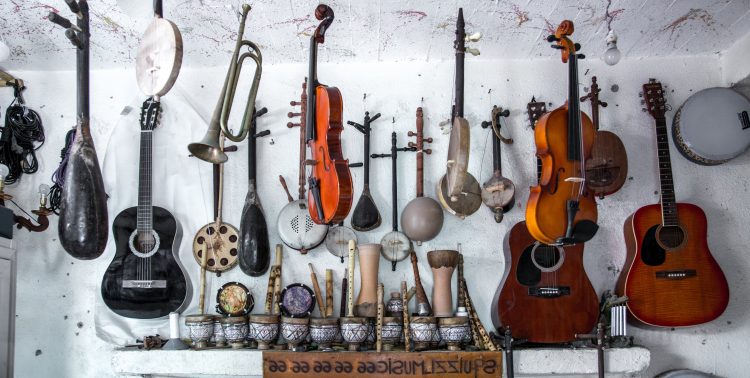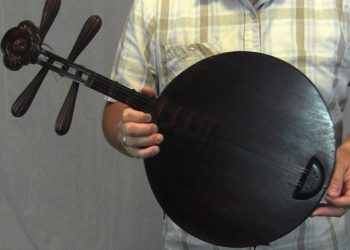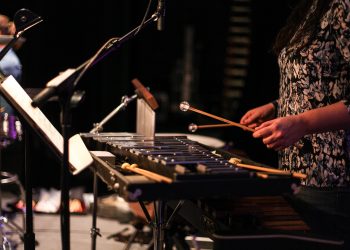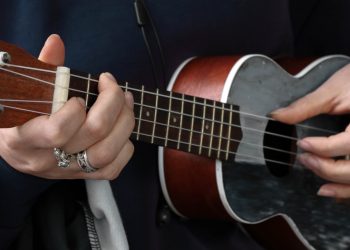Music is a universal language that has been a part of human civilization since ancient times. Over the years, musicians and inventors have come up with a plethora of musical instruments, each with its unique sound and character. Among the vast array of instruments, there are some that begin with the letter F, and they are nothing short of amazing. From the delicate sound of a flute to the booming voice of a full-sized grand piano, there is no shortage of instruments that start with this letter that can create some truly beautiful music.
In this article, we will be exploring the top 16 musical instruments that start with the letter F. We will dive into the history and origin of each instrument, as well as its unique qualities and how it is played. Whether you are a musician, a music lover, or just someone curious about the world of music, this article is sure to pique your interest and introduce you to some fantastic instruments that you may not have known about before. So without further ado, let us delve into the world of music and discover some of the most remarkable instruments that begin with the letter F.
1. Fiddle
The fiddle is a type of stringed instrument that has been played for centuries. It produces sound by pulling or bowing strings, and its distinctive timbre makes it one of the most beloved instruments in traditional music. The fiddle can be used to play a variety of styles from jazz to folk, giving it an incredibly versatile character.
In order to get the best sound out of a fiddle, it’s important for players to have mastered both right-hand and left-hand techniques. Right-hand technique involves using the bow across the strings while controlling the speed and pressure; this allows you to create different dynamics within each note. Left-hand technique focuses on fingering chords and playing melodies with precision. Both these skills are essential if you want to master the art of playing the fiddle effectively.
Although learning how to play the fiddle may seem daunting, there are some great resources available online which make getting started easier than ever before. From tutorials teaching basic techniques such as holding your instrument correctly and tuning it up, through to more advanced topics like how to read sheet music – whatever level you’re at, there’s something out there for everyone!
No matter what style of music you prefer, mastering the fiddle will undoubtedly add color and texture to any performance. Whether soloing over a backing track or jamming alongside other musicians – adding a few tunes on your fiddle can take things up a notch! With practice and perseverance anyone can become an expert musician who knows their way around this beautiful instrument.
2. Finger Cymbals
Having mastered the fiddle, why not try your hand at finger cymbals? These small metallic clappers have a long history of being used in musical performances, whether it’s to add an extra layer of sound or as a solo instrument. Unlike other percussion instruments, they don’t require drums or any additional equipment – just two hands and some rhythmic chops!
Finger cymbals are incredibly easy to learn, but mastering them can be challenging. To get started, hold the cymbals between your fingers and thumbs with one side facing up towards you. Then use quick hand movements to hit each against the other while controlling the speed and volume; this will create dynamic patterns that become more complex over time. Practice regularly and soon enough you’ll be able to play intricate rhythms with ease.
Finger cymbal playing is all about experimenting with different techniques such as open and closed sounds, rolls and accents, trills, mutes and crescendos – all which allow for creative expression. With some practice these skills can be developed into beautiful solos that captivate audiences everywhere. It’s also important to remember that like many forms of music making, timing is key so make sure you’re keeping track of beats when practicing!
Ultimately finger cymbals can provide hours upon hours of fun thanks to their portability and nostalgic timbre. Whether played alone or alongside other musicians – adding them into compositions brings a unique flavor that adds texture and atmosphere to any performance! So if you’re looking for a new challenge on your musical journey then give fingering cymbals a go – it could take your talent to the next level!
3. Firikyiwa
The Firikyiwa is a percussion instrument from West Africa, originating in the country of Ghana. It is made from a dried gourd covered with netting that houses several smaller calabashes filled with pebbles or seeds. The player shakes and strikes these objects to create unique rhythms and sounds. This traditional African instrument has been used for centuries to accompany singing and dancing at many cultural events including weddings, festivals, and religious ceremonies.
The Firikyiwa can be played alone or as part of an ensemble. Its sound adds texture and color to any musical arrangement – perfect for adding excitement to songs like highlife or afrobeat! When playing this instrument it’s important to pay attention to detail; small variations in how you strike each object will produce different tones which can dramatically alter the feel of your song. Additionally, by controlling the speed and intensity of your strokes you’ll be able to precisely control the mood and energy level of your performance.
Playing the Firikyiwa requires patience but is incredibly rewarding when done correctly. Mastering its techniques takes time as does learning how best to use it within various musical contexts – whether accompanying singers, dancers, or other instruments. With practice comes confidence however; soon enough you’ll find yourself creating exciting new grooves on-the-fly!
So if you’re looking for something fresh then why not give the Firikyiwa a go? Whether performing solo or jamming out with friends, this captivating instrument promises hours of fun while providing endless possibilities for sonic exploration. You never know what kind of music awaits until you try it out!
4. Flageolet
Moving on from the fisarmonica, another Italian folk instrument is a unique and lesser known instrument called the flageolet. This wooden whistle-like device has been around since at least the 16th Century and can be found in many traditional musical styles throughout Europe. Whilst not as popular as other instruments such as accordions or violins, it’s still used today to add an interesting texture to songs.
The flageolet is played by blowing into one end of its double reed while manipulating two fingerholes with your left hand. This creates a sound that is both delicate yet full of character – perfect for accompanying slower pieces or providing contrast when combined with louder instruments like drums or electric guitars. It also lends itself well to improvisation thanks to its limited range which gives you plenty of room to explore different melodic ideas without getting too complicated!
Although mastering this ancient instrument may take some practice, there are lots of resources online including tutorials and sheet music downloads so you don’t have to go it alone. Learning how to play scales and arpeggios will help you develop greater control over your fingers whilst honing in on specific techniques – enabling you to create beautiful melodies effortlessly. You can even learn how to incorporate vibrato or glissando into certain passages for added expression – adding more depth and emotion to your playing.
Once you’ve got the basics down, why not try out some simple tunes? There’s no better way than experimenting with real music to see what works best for each particular song, allowing you to truly express yourself musically. So get creative and have fun!
5. Flamenco Guitar
From the gentle tones of the flageolet to the vibrant rhythms of a different type of stringed instrument, let’s now journey into the world of Flamenco. This style of music originated in Andalusia in southern Spain and is characterized by its fast strumming patterns and unique percussive sounds. At its core lies an acoustic guitar with nylon strings that helps create a distinctive sound when coupled with other traditional instruments such as castanets or handclaps.
To start playing this passionate form of music yourself, you’ll need to learn about techniques like arpeggios and tremolo – both used extensively in Flamenco pieces. Arpeggios are quick successions of notes played one at a time while tremolo involves rapidly alternating between two notes on consecutive beats. As you progress through your practice sessions, make sure to use these techniques sparingly so they don’t become monotonous! Additionally, try incorporating slides up and down the fretboard for added texture – it can help bring out a whole new level of emotion within any piece.
Once you’re comfortable with basic chords and fingerpicking styles, there are plenty more advanced concepts to explore such as improvisation or intricate rasgueados (strums). These involve combining several rhythmic patterns together which may require some patience but will greatly enhance your overall performance if done correctly. There are also many classic songs from renowned artists like Paco De Lucia or Carlos Montoya that offer great challenges for intermediate players who want to push their skills further.
Playing Flamenco is all about having fun whilst staying true to tradition so take inspiration from those before you, experiment with different ideas and never be afraid to go off course! With enough dedication and passion behind each note, soon enough you’ll find yourself immersed in the culture – creating infectious melodies full of energy and spirit!
6. Flexatone
Having explored the passionate and vibrant world of Flamenco, let’s now turn our attention to a much more unique instrument – the Flexatone. This peculiar contraption is composed of two metal rods that cross each other at right angles and are connected by strings which can be plucked or struck with mallets. It produces an array of strange metallic sounds that range from eerie chimes to piercing jangles – perfect for adding some mystery to any musical composition!
The beauty of this instrument lies in its versatility; it can imitate many different noises such as bells, gongs, drums or even bird calls. By using combinations of strumming, hitting and vibrato techniques, it’s possible to create all sorts of intriguing textures and tones. While you may need to practice hard to get comfortable controlling these nuances, once mastered they will add a layer of depth and complexity to your playing style that few instruments can match.
When used correctly within compositions, the Flexatone can be incredibly effective in creating tension-filled moments or providing gentle accompaniment sections – depending on what mood you intend to evoke. Additionally, if you’re just starting out then why not give percussive patterns a go? With its wide timbre spectrum it won’t take long before you find yourself producing beautiful melodies without having ever picked up a guitar!
The Flexatone is undoubtedly one of the most interesting instruments around so don’t hesitate – start exploring its possibilities today! Whether you want to craft delicate soundscapes or energetic rhythms – there really is no limit when experimenting with this incredible tool. So dive into its depths and discover how far your creativity will take you!
7. Floghera
Our next musical instrument is the Floghera, a traditional Mexican type of flute. This instrument has an elongated tube-like structure with three fingerholes and one thumbhole, which allows players to produce a variety of notes by changing the position of their fingers on the holes. The sound produced by this unique wind instrument ranges from soft and mellow tones to higher pitched melodies.
The Floghera provides great versatility in terms of playing styles due to its design and construction – you can play fast or slow patterns, long sustained notes or intricate rhythms depending on your preference. Additionally, it’s relatively easy to learn compared to other woodwind instruments so if you’re just starting out then definitely give it a go!
This lovely sounding flute also offers plenty of potential for creating beautiful music along with other musicians – be it folkloric tunes or modern classics – as well as when performing solo pieces. You’ll soon find yourself exploring exciting new avenues while discovering more about yourself musically too! So why not pick up a Floghera today and start developing your skills?
Whether you’re looking for something that will help you relax after a long day at work or inspire creativity during jams session with friends, this amazing instrument won’t disappoint! With its wide range of sounds available and ease of use, there are countless possibilities for expressing emotions through music – all waiting for you to explore!
8. Flugelhorn
Following in the footsteps of the Floghera, let’s now explore what a flugelhorn can bring to our musical journey. With its mellow and warm tones, this brass instrument is sure to add an extra layer of richness to any ensemble or solo performance. The valve structure and conical bore give it a unique sound that only gets better with practice – allowing you to develop your own style as you progress.
The flugelhorn has been around for centuries, but still maintains its popularity today due to its versatility. You’ll find it used in both traditional and modern music genres such as jazz, classical, pop, rock, funk and more! Its ability to create subtle nuances makes it perfect for expressing emotion through beautiful melodies too – whether you’re playing something slow and gentle or upbeat and groovy.
You don’t have to be a professional musician either; anyone can learn how to play the flugelhorn with enough dedication! There are plenty of resources available online if you need help getting started – from tutorials on basic technique all the way up to advanced improvisation techniques. And because of its smaller size compared to other instruments like trumpets, it’s much easier for beginners (especially younger players) to manage.
So why not get yourself set up with one today? Whether you’re looking for something different than conventional wind instruments or just wanting some new sounds for your current project – the flugelhorn is definitely worth considering! With a bit of effort and creativity there are endless possibilities awaiting discovery so go out there and make some beautiful music!
9. Flute
Following the mellifluous tones of the flugelhorn, we can now move on to explore a classic instrument: the flute. This treasured wind instrument has been around for centuries and is still used today in many genres such as classical, jazz, pop, rock, funk and more! Its lightness and ease of playability make it an ideal choice for beginners – no matter what age or skill level you are.
The beauty of playing this versatile instrument lies within its subtle nuances; with enough practice and experience you’ll be able to create a unique sound that expresses your own emotions through beautiful melodies. The tone from a well-made flute is also incredibly pleasing; sweet highs paired with warm lows gives any piece of music a special touch that will captivate listeners.
Aside from its use in traditional settings, there’s also plenty of opportunities to experiment with different styles too – so why not give it a go? Whether it’s by using effects pedals or incorporating modern techniques into your pieces – there’s lots of potential waiting to be explored! And if you’re short on time then try out some pre-recorded backing tracks which have recently become popular amongst musicians looking for new ways to enhance their performances.
So why not get yourself set up with one today? With enough dedication and creativity there are endless possibilities awaiting discovery – go out there and make some beautiful music!
10. Flutophone
Moving on from the flute, let’s take a look at another fun and easy-to-play instrument: the Flutophone. This simple yet effective tool has been around since the 1960s and is still popular amongst those looking to learn more about music production and performance. Unlike other wind instruments, it does not require any kind of prior knowledge or skill level; anyone can pick it up and quickly get to grips with its basic functions.
Its sound ranges between mellow highs and deep lows which gives users plenty of room for experimentation when creating their own pieces. To make things even easier there are also tons of instructional videos online that show you how to play various notes – so you don’t need to worry if you’re feeling overwhelmed! Plus, many models come with pre-recorded backing tracks too – making your journey into learning this versatile instrument all the smoother.
The best part? It doesn’t have to break the bank either – most models won’t cost an arm and a leg. And once you’ve got one, why not join in some local jams or start a band of your own? There’s no limit as to what you can do with just one instrument – create something totally unique!
It only takes dedication and creativity for great results – so grab yourself a Flutophone today and give it a go! Who knows where your musical journey could lead…
11. Fortepiano
Ready to explore another classic instrument? Let’s take a look at the Fortepiano, an ancestor of today’s pianos. This unique piece of musical history is loved by many for its distinct sound and ease of use. It has been around since the 18th century and was used in some of classical music’s most iconic pieces – from Mozart to Beethoven!
Unlike other instruments, the fortepiano gives players more control over their sound because they can adjust the volume while playing due to its mechanism design. For this reason, it can be a great choice even if you’re just starting out; you don’t need any prior experience or skill level – simply have fun experimenting with different sounds as you learn how to play.
Plus, there are hundreds of pre-recorded songs available online that you can download and practice along with – so why not give them a go? You could also join in local jams or start your own band! The possibilities are endless when it comes to mastering this ancient yet timeless instrument.
But no matter which route you choose, one thing remains certain: dedicating time and effort will bring about amazing results. So grab yourself a Fortepiano and get creative – who knows where your journey may lead?
12. Fotuto
I’ll start by talking about the most popular instrument: the guitar. It’s one of the oldest string instruments, and its sound is recognizable in many genres of music. The acoustic guitar has a mellow, resonant tone that can be used for both strumming and picking techniques. Electric guitars are more versatile, as they offer distortion effects which give them a unique character. They’re also much louder than their acoustic counterparts.
Next up is the piano. This classic instrument produces beautiful sounds with a wide range of expression possibilities due to its keys and pedals. Pianos come in two main types – digital or acoustic – each with its own distinct feel and sound quality. Digital pianos use sampled recordings instead of strings or hammers, while acoustic models rely on wooden components to create their tones.
Drums are another important part of any musical ensemble; they provide rhythm and groove to songs like no other instrument can! Drums consist of several parts such as kick drums, snare drums, cymbals, hi-hats, tom-toms etc., all contributing to creating complex rhythms. Drummers often play intricate patterns using drumsticks or brushes to get different sounds out of these pieces of equipment.
Wind instruments have been around since ancient times too; flutes, clarinets, trumpets and saxophones are just some examples of these air-filled wonders! Each type has its own distinctive timbre which helps add texture to an arrangement when played together with other instruments. These days musicians tend to mix traditional wind instruments with electronic ones to create new sonic textures altogether.
So there you have it! From plucked strings to striking skins and blowing into brass tubes – musical instruments continue to bring joy through generations despite technological advances in recent decades.
13. Frame Drum
The Frame Drum is a percussion instrument that has been around for centuries. It’s usually played with the hands and produces a rich, warm tone. The frame drum consists of a single membrane stretched over a wooden or metal hoop that can be adjusted to create different notes. They come in many sizes and are used in styles ranging from folk music to jazz and classical music.
Frame drums have an instantly recognizable sound; they produce deep bass tones when hit harder, as well as delicate high-pitched ringing sounds when struck lightly. This versatility makes them perfect for accompanying other instruments or providing the backbeat for solo performances. They’re also great for improvisation, allowing musicians to explore new musical ideas without having to worry about hitting wrong notes!
Most people think of frame drums as being traditional instruments but there are actually quite a few modern variations out there too. Electronic frame drums are popular among EDM producers due to their ability to generate unique rhythmic patterns quickly and easily. And if you want something even more exotic sounding, try an ethnic handpan – this type of frame drum combines elements from both Eastern and Western culture into one beautiful sounding instrument.
No matter what style of music you’re playing, the frame drum will provide you with plenty of opportunities to express yourself artistically through rhythmical complexity. Its distinctive sound is sure to add texture and depth your performance – so why not give it a try?
14. French Horn
The French Horn is a beautiful and evocative instrument that has been used in music for centuries. It’s the only brass instrument to feature both an upward-facing bell and a conical bore, making it distinct from other instruments of its type. Its sound ranges from mellow and lyrical to powerful and bold – depending on how it’s played!
French horns are usually found in symphonic orchestras, but they’re just as versatile when played solo or with smaller ensembles. They provide a rich texture due to their ability to blend well with other instruments, while still having enough presence to stand out on their own. This makes them perfect for jazz solos or adding some drama to classical pieces.
When playing the French horn, musicians must pay attention not only to pitch but also volume control; this instrument can be quite loud if you don’t practice proper techniques like breath support and tonguing correctly! But once mastered, the results can be truly breathtaking: each note carries emotion and depth that adds richness to any musical arrangement.
This unique combination of melodic expression and dynamic range makes the French horn ideal for creating captivating compositions. Whether you’re looking for soaring melodies or lush harmonies, there’s no doubt that it will add something special to your music – so why not give it a try?
15. Fujara
The fujara is an ancient and unique wind instrument that has been used in Central European music for centuries. Unlike the French horn, it’s a woodwind instrument with a single reed which produces a haunting sound when blown through its long tube. It’s characterized by its high-pitched melody, as well as its distinctive shape – resembling a shepherd’s staff or flute.
What makes the Fujara so special is its ability to produce various tones at once; this gives it an ethereal quality that many find captivating. As you move up and down the range of notes, each note blends together seamlessly – creating complex harmonies that can be both calming and uplifting. Additionally, due to its length, performers have more control over their tone than they would on other instruments – allowing them to craft intricate melodies from simple scales.
The Fujara also excels at improvisation; musicians often use traditional folk tunes as inspiration for spontaneous solos. This allows for endless creativity, making every performance unique and engaging! Plus, because of its portability, it’s easy to take your show on the road – perfect for buskers or festival-goers looking to add some extra flair to their sets.
So if you’re looking for something different to spice up your musical arrangements, then give the Fujara a try! With its wide range of sounds and styles, there’s sure to be something here that will fit right into your repertoire – no matter what type of music you play.
16. Fujara Trombita
Building on the unique sound of the Fujara, is a similar yet distinct instrument known as the Fujara Trombita. This traditional Slovakian woodwind instrument consists of two separate tubes that are joined together to form a single instrument. It produces an even more complex and beautiful sound than its predecessor – blending several pitches into one harmonious melody!
The first tube is fitted with three reeds that produce different notes depending on how they’re blown; this allows for more versatility in range and tone than the original Fujara. The second tube contains four small pipes which can be used to create intricate rhythms or trills – adding further depth to your music. Additionally, due to its size, it’s easy enough to transport from gig-to-gig without any hassle.
On top of this, many performers have found ways to incorporate both instruments into their performances – creating pieces that seamlessly blend ancient traditions with modern innovation. By mixing these sounds together, musicians are able to craft entirely new musical experiences that will captivate audiences wherever they go!
In short, if you’re looking for something truly special and unique then look no further than the Fujara Trombita. With its multi-faceted capabilities and portability, there’s sure to be something here that fits perfectly within whatever style of music you choose to play.









